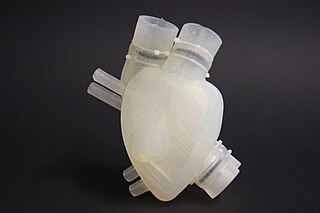Related Research Articles
A quality management system (QMS) is a collection of business processes focused on consistently meeting customer requirements and enhancing their satisfaction. It is aligned with an organization's purpose and strategic direction. It is expressed as the organizational goals and aspirations, policies, processes, documented information, and resources needed to implement and maintain it. Early quality management systems emphasized predictable outcomes of an industrial product production line, using simple statistics and random sampling. By the 20th century, labor inputs were typically the most costly inputs in most industrialized societies, so focus shifted to team cooperation and dynamics, especially the early signaling of problems via a continual improvement cycle. In the 21st century, QMS has tended to converge with sustainability and transparency initiatives, as both investor and customer satisfaction and perceived quality are increasingly tied to these factors. Of QMS regimes, the ISO 9000 family of standards is probably the most widely implemented worldwide – the ISO 19011 audit regime applies to both and deals with quality and sustainability and their integration.

Current good manufacturing practices (cGMP) are those conforming to the guidelines recommended by relevant agencies. Those agencies control the authorization and licensing of the manufacture and sale of food and beverages, cosmetics, pharmaceutical products, dietary supplements, and medical devices. These guidelines provide minimum requirements that a manufacturer must meet to assure that their products are consistently high in quality, from batch to batch, for their intended use. The rules that govern each industry may differ significantly; however, the main purpose of GMP is always to prevent harm from occurring to the end user. Additional tenets include ensuring the end product is free from contamination, that it is consistent in its manufacture, that its manufacture has been well documented, that personnel are well trained, and that the product has been checked for quality more than just at the end phase. GMP is typically ensured through the effective use of a quality management system (QMS).
Allotransplant is the transplantation of cells, tissues, or organs to a recipient from a genetically non-identical donor of the same species. The transplant is called an allograft, allogeneic transplant, or homograft. Most human tissue and organ transplants are allografts.
GxP is a general abbreviation for the "good practice" quality guidelines and regulations. The "x" stands for the various fields, including the pharmaceutical and food industries, for example good agricultural practice, or GAP.

A medical device is any device intended to be used for medical purposes. Significant potential for hazards are inherent when using a device for medical purposes and thus medical devices must be proved safe and effective with reasonable assurance before regulating governments allow marketing of the device in their country. As a general rule, as the associated risk of the device increases the amount of testing required to establish safety and efficacy also increases. Further, as associated risk increases the potential benefit to the patient must also increase.
A biopharmaceutical, also known as a biological medical product, or biologic, is any pharmaceutical drug product manufactured in, extracted from, or semisynthesized from biological sources. Different from totally synthesized pharmaceuticals, they include vaccines, whole blood, blood components, allergenics, somatic cells, gene therapies, tissues, recombinant therapeutic protein, and living medicines used in cell therapy. Biologics can be composed of sugars, proteins, nucleic acids, or complex combinations of these substances, or may be living cells or tissues. They are isolated from living sources—human, animal, plant, fungal, or microbial. They can be used in both human and animal medicine.

Organ printing utilizes techniques similar to conventional 3D printing where a computer model is fed into a printer that lays down successive layers of plastics or wax until a 3D object is produced. In the case of organ printing, the material being used by the printer is a biocompatible plastic. The biocompatible plastic forms a scaffold that acts as the skeleton for the organ that is being printed. As the plastic is being laid down, it is also seeded with human cells from the patient's organ that is being printed for. After printing, the organ is transferred to an incubation chamber to give the cells time to grow. After a sufficient amount of time, the organ is implanted into the patient.
The Center for Biologics Evaluation and Research (CBER) is one of six main centers for the U.S. Food and Drug Administration (FDA), which is a part of the U.S. Department of Health and Human Services. The current Director of CBER is Peter Marks, M.D., PhD. CBER is responsible for assuring the safety, purity, potency, and effectiveness of biologics and related products. Not all biologics are regulated by CBER. Monoclonal antibodies and other therapeutic proteins are regulated by the FDA Center for Drug Evaluation and Research (CDER).
Validation is the process of establishing documentary evidence demonstrating that a procedure, process, or activity carried out in testing and then production maintains the desired level of compliance at all stages. In the pharmaceutical industry, it is very important that in addition to final testing and compliance of products, it is also assured that the process will consistently produce the expected results. The desired results are established in terms of specifications for outcome of the process. Qualification of systems and equipment is therefore a part of the process of validation. Validation is a requirement of food, drug and pharmaceutical regulating agencies such as the US FDA and their good manufacturing practices guidelines. Since a wide variety of procedures, processes, and activities need to be validated, the field of validation is divided into a number of subsections including the following:
Title 21 is the portion of the Code of Federal Regulations that governs food and drugs within the United States for the Food and Drug Administration (FDA), the Drug Enforcement Administration (DEA), and the Office of National Drug Control Policy (ONDCP).
Biomedical Tissue Services (BTS) was a Fort Lee, New Jersey, human tissue recovery firm that was shut down by the U.S. Food and Drug Administration (FDA) on October 8, 2005, after its president, Dr. Michael Mastromarino, and two other employees were convicted of illegally harvesting human bones, organs, tissue and other cadaver parts from individuals awaiting cremation, for forging numerous consent forms, and for selling the illegally obtained body parts to medical companies without consent of their families.

The United States Food and Drug Administration Modernization Act of 1997 (FDAMA) amended the Federal Food, Drug, and Cosmetic Act. This act is related to the regulation of food, drugs, devices, and biological products by the FDA. These changes were made in order to recognize the changes in the way the FDA would be operating in the 21st century. The main focus of this is the acknowledgment in the advancement of technological, trade, and public health complexities.
Good documentation practice is a term in the pharmaceutical and medical device industries to describe standards by which documents are created and maintained. While some GDP / GDocP standards are codified by various competent authorities, others are not but are considered cGMP. Some competent authorities release or adopt guidelines, and they may include non-codified GDP / GDocP expectations. While not law, authorities will inspect against these guidelines and cGMP expectations in addition to the legal requirements and make comments or observations if departures are seen. In the past years, the application of GDocP is also expanding to cosmetic industry, excipient and ingredient manufacturers.
The U.S. Food and Drug Administration (FDA) is authorized to perform inspections under the Federal Food, Drug, and Cosmetic Act, Sec. 704 "Factory Inspection". Form FDA 483, "Inspectional Observations," is a form used by the FDA to document and communicate concerns discovered during these inspections. Also referred to as "Form 483" or merely "483", it states thereon that it
... lists observations made by the FDA representative(s) during the inspection of your facility. They are inspectional observations, and do not represent a final Agency determination regarding your compliance
An FDA warning letter is an official message from the United States Food and Drug Administration (FDA) to a manufacturer or other organization that has violated some rule in a federally regulated activity.

United States of America v. Regenerative Sciences, LLC, 741 F.3d 1314, was a decision in the United States Court of Appeals for the District of Columbia Circuit filed on February 4, 2014 concerning more than minimally manipulated cell therapies and whether they are considered part of medical practice or a drug, the latter subjecting it to regulation under the Food and Drug Administration (FDA). Regenerative Sciences LLC marketed a therapy procedure called Regenexx-C for the treatment of arthritis and orthopedic injury that involved extraction and culture of mesenchymal stem cells from the same patient which were later reinjected. In 2008, The FDA notified Regenerative Sciences LLC that the procedure may not be in compliance with their regulation using an Untitled Letter, which began a series of suits and counter suits, leading to the 2014 decision upholding the FDA’s regulation of more than minimally manipulated stem cell therapies.
Guidances for statistics in regulatory affairs are applicable to the pharmaceutical industry and medical devices industry. These Guidances represent the current thinking of regulatory agencies on a particular subject. It is to be noted that the term “Guidances” is used in the USA, whereas the term “Guidelines” is used in Europe.
In medicine and food law, a test article is a prototype product specifically manufactured to test the product. Since medical and food test products involve human safety, they are subject to legal regulation.
Due to the many regulations in the industry, the design of medical devices presents significant challenges from both engineering and legal perspectives.
Minimally manipulated cells are non-cultured (non-expanded) cells isolated from the biological material by its grinding, homogenization or selective collection of cells, which undergo minimal manipulation. Minimally manipulated cells are usually using for the treatment of skin ulceration, alopecia, and arthritis.
References
- ↑ "2005 CFR Title 21, Volume 8". Archived from the original on 2008-03-09. Retrieved 2007-12-15.
- ↑ "FDA/CBER - Questions and Answers Concerning the Current Good Tissue Practice (CGTP) Final Rule".
- ↑ "January 2009 FDA Draft Guidance for Industry" (PDF).